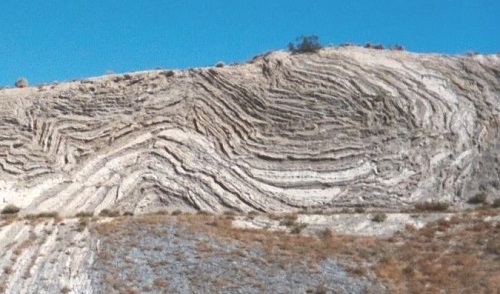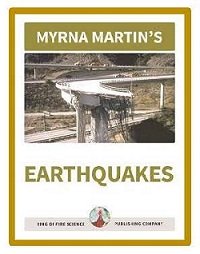Faults Move Up, Down, and Sideways
What causes faults to move
Normal, reverse and transform faults
Earthquake faults are caused by the Earth's crust moving upward, downward, and sideways. Normal faults occur when plates move apart. Reverse faults develop when plates smash together. Transform faults are caused by two plates moving horizontally apart. The picture below shows movement along the San Andreas Fault as the Pacific Plate moves northward relative to the North American Plate.

Rocks layers that have moved along the San Andreas Fault
What are Faults?
Faults are areas between two block of land that move
Faults are areas between blocks of land that allows the land to move upward, downward or sideways. When the blocks of land are locked together and pressure builds in the rocks on either side of the fault line the rocks can break apart. When the rocks break apart creating an earthquake they can move along the fault line.
Distance the plates move often determines the magnitude of the earthquake
Sometimes the length of movement is only a few centimeters. Other times the movement can occur along a fault line for thousands of kilometers. The length of the fracture often determines the magnitude of the earthquake and the destruction caused by the plate movement.
Faults in subduction zones
Subduction zone faults form where one plate is being forced beneath another plate. The fault line in these areas can be hundreds of kilometers long. When they break along this fault line it creates great earthquakes that can be over 9.0 on the moment magnitude scale.


Click for More Information and to Order
Normal and Reverse Faults
Normal earthquake faults develop in areas where land is pulling apart or stretching. The rocks fracture and one block of land slips downward in relation to the block of land on the other side of the fault zone.
A reverse fault develops in areas where land masses are coming together. The land is compressed and one side of the fault moves upward.
Thrust Faults
If the angle between the two land masses is less than 45 degrees one section may slip over another without reaching the surface. Faults with less than a 45 degree angle are thrust faults.
San Andreas Fault
The San Andreas Fault is a strike slip fault. If you stand on either side of the San Andreas Fault it looks like the land has moved to the right. Scientists call this type of fault a right lateral strike slip fault. During the 1906 San Francisco earthquake a road at Tomales Bay was offset 7 m (21 ft).
Transform fault
The San Andreas Fault is also called a transform fault. This type of fault is found in the middle of the oceans where plates are moving apart. The transform fault connects two normal faults that are separated due to the curvature of the Earth.
KIDS FUN Science Bookstore
Check out Myrna Martin's award winning textbooks, e-books, videos and rock sets. The Kids Fun Science Bookstore covers a wide range of earth science topics. Click here to browse.










